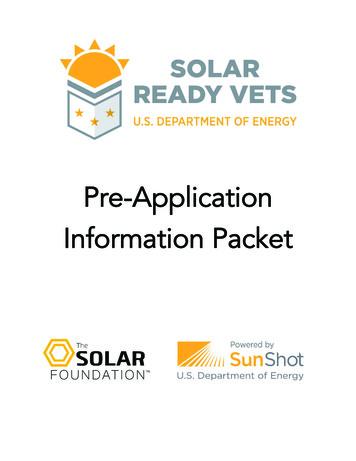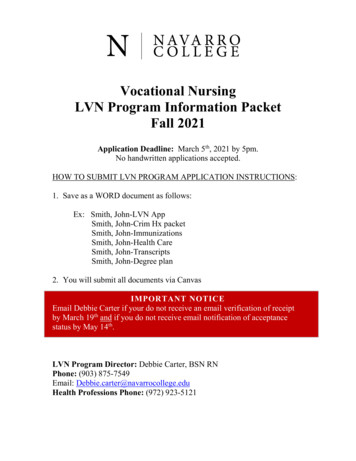
Transcription
Pre-ApplicationInformation Packet
Solar Ready Vets Program Eligibility RequirementsTo be eligible for the Solar Ready Vets solar workforce training program, applicantsmust: Be interested in the solar industry and have interest in pursuing a career or additionaleducation in solar. Have completed the Transition Assistance Program. Be within 120 days of exit from military service at the start of training (can be within 180 daysto apply for the training). Be willing to use no more than 2 months of their GI Bill benefits to attend the course. Participate in all course and training activities for the full duration of the program*. (Absencesfrom training must be approved by base command and coursework made up with the traininginstructors on the Applicant’s personal time.) Have a signed endorsement by your Commanding Officer or designated authority oncommand letterhead. Provide with application a copy of your “Member Data Summary” from your ElectronicService Record (ESR). Provide with application your 1-2 page resume. Participate in course evaluations and post-course follow-up surveys (conducted via phone oremail) for employment and relocation tracking and program feedback for up to 1 year aftergraduation. Have reviewed the information packet provided by your career counselor prior to completingthe application.
Solar Ready Vets Curriculum OverviewThe Purpose of the Solar Ready Vets (SRV) Program is to: prepare transitioning service members for careers in the solar industry provide skilled workers with high quality training to meet industry demands build solar training capacity for local training providers, particularly community collegesProgram Design: The minimum four-week SRV program includes four sets of program learning goalsaligned around (1) the North American Board of Certified Energy Practitioners Entry Level Exam(NABCEP ELE); (2) hands-on experience with solar system site analysis, design, installation,commissioning, operation, maintenance; (3) Safety issues unique to solar plus OSHA 10 or 30(chosen at discretion of installation and training provider); (4) Transition planning and individualsupport of entry into the solar industry. These goals, and the learning objectives associate with each,are pursued in parallel during the course.Course Objectives: Upon completion of this course, participants will be: knowledgeable of fundamental photovoltaic systems, concepts, and learning objectivesdefined by the NABCEP. experienced in core processes of solar PV projects including basic site analysis, systemdesign, system assembly, commissioning, inspection, maintenance, and financial analysis. familiar with the solar industry, career paths, and job opportunities that leverage their uniqueskills, traits, and interests. certified as completing either OSHA 10 or 30 Safety training. required to sit for the NABCEP Entry Level Exam.Course Materials: Course materials include handouts to support note taking during classpresentations and activities, online materials and resources, and the course textbook, “PhotovoltaicSystems”, 3rd Edition by James Dunlap.Hands-on Learning Experiences and Labs: The SRV program provides hand-on experience usingactual PV systems. Four sets of equipment are required for select activities including site analysis,electrical measurement devices and systems for assembly (grid tied/grounded, micro inverter,battery systems). At least one permanent system with monitoring data should also be accessible tostudents, and one nearby utility scale system (preferably on base) is suggested for case study andsite visit purposes.Successful Completion: Participants will be granted permission to participate in the culminatinghiring event and graduation based upon: participation in daily course activities and required content. completion of daily quizzes and a mid-term examination. demonstration of career planning, resume, and interview skills. completion of NABCEP Entry Level Exam.
Jobs in the Solar IndustryThe American solar industry is growing at a tremendous rate. Over the last several years, the sectorhas consistently added jobs at a much faster rate than the rest of the economy. The solar industryrepresents a great opportunity for many transitioning military personnel – solar companies interestedin hiring regularly seek out veterans due to their discipline, work ethic, experience, and ability tolearn new skills. According to the Interstate Renewable Energy Council (IREC), there are four maincategories of solar jobs:1. Manufacturing The manufacturing sector combines elements of engineering and electronics to createefficient and reliable solar products. Solar manufacturing is a good fit for those with aknack for wiring and a passion for creating quality products.2. System Design System design requires knowledge of software and coding and the inventiveness todesign innovative products. System designers – must have the vision and criticalthinking skills to create new products and mechanisms that will move solar energyforward.3. Project Development After a solar PV product is designed and manufactured, the next step is deploying thetechnology. Project development entails assessing sites for solar suitability, marketingthe products, and selling the products to customers.4. Installation & Operations The final step of delivering solar products to customers is through installation andoperations. This sector entails being part of a team of solar technicians that workstogether to install products in an efficient and consumer-friendly way. Installers areoften the face of the operation – they are the team members who directly interact withthe customer. Safe installation and product maintenance is vital to obtaining customerloyalty, making installation teams a crucial part of the proliferation of the solar industry.For more detailed information about specific jobs within each of these categories, please see IREC’ssolar career map at www.irecsolarcareermap.org.
STATE SOLAR JOBS CENSUS 2015The Solar Jobs Census series is a product of The Solar Foundation , an independent 501(c)(3)nonprofit organization whose mission is to increase understanding of solar energy through strategicresearch that educates the public and transforms markets. The most recent installment of the NationalSolar Jobs Census found that the U.S. solar industry currently employs 208,859 workers, a figure whichrepresents 20.2% growth in employment over the previous year. This growth rate makes 2015 the thirdconsecutive year in which employment increased by 20% or more. Since TSF first began tracking solaremployment in 2010, the industry has grown by 123%, resulting in nearly 115,000 new, well-paying, domesticjobs. In 2012, TSF began estimating solar employment in each of the 50 states, and introduced stand-aloneCensus reports for select states the following two years. This factsheet summarizes the results from the 2015State Solar Jobs Census effort.State of the StatesA Deeper DiveSolar jobs continue to grow across the country,almost 12 times faster than the overall economysince 2014, and most states continue to see robustsolar development. Thirty-three states (includingthe District of Columbia) saw positive growth overthe past year. While this growth was observed inall regions of the country, solar employment ismore concentrated today, with the Top-2 solarstates accounting for over 50% of the employmentgrowth since 2014.Since 2013, TSF has produced stand-alone statereports. In 2014, TSF included district-level data for 3states – California, Arizona, and Minnesota – and in2014, TSF produced full reports for 6 states –California, Arizona, Texas, New York, Georgia andMaryland. This year, TSF produced 14 stand-aloneSolar Jobs Census reports (for AZ, CA, CO, FL, MA, MI,MN, NC, NJ, NM, NY, TX, UT, and VT) and a 51-stateCompendium report, which includes Census datafor all 50 states and features regional summariesfor each of the nine divisions. Finally, TSF hasproduced MSA, county, and federal and stateCongressional district data for all 50 states.As in previous years, California continues to lead inboth solar employment and installed solarcapacity. Of the 75,598 solar workers in the state,60% are employed in the installation sector. By theend of 2016, California is expected to account forover 90,000 solar workers.Massachusetts retained its position as the secondlargest solar employer in the U.S. and passed the15,000 solar workers benchmark. Colorado edgedout Ohio to move into the top-10 in total solar jobs.Rhode Island, South Carolina, and Nebraska werethe top-3 in solar job growth since 2014.Utah’s solar workforce grew an estimated 76.8%,propelling the state 8 places in the solar statesrankings from #27 into the top-20.Key Data from the State Census reportsHighest % Solar Jobs Growth:1. Rhode Island, 2. South Carolina, 3. Nebraska,4. Tennessee, 5. Louisiana.Most Solar Jobs Per Capita:1. Nevada 2. Massachusetts, 3. Vermont, 4. Hawaii,5. CaliforniaHighest % Solar Capacity Growth 2014-15 (estimated):1. South Carolina, 2. Utah, 3. Georgia, 4. Oregon,5. New Hampshire.Visit SolarStates.org for our 51-state Compendium report & 14 stand-alone state reports,including solar jobs data at the metro, county, and district levels; and check outTSFcensus.org for our National Solar Jobs Census 2015.
States Gaining GroundIn addition to California and Massachusetts: Nevada,Florida, Maryland, Tennessee, Oregon, Michigan, andUtah are among the top 20 solar jobs states that grewby 30% or more. Since The Solar Foundation beganestimating state-level solar employment in 2012,nearly half the states in the nation have doubled (ormore) the size of their solar workforce. Thirty-threestates (including the District of Columbia) sawpositive growth over 2014.The 2015 Census reports also show parallel growth inthe total amount of installed capacity.SolarStates.orgTop Twenty Solar Jobs States - 2015StateSolar Workers2015Solar Workers2014Rank2015 (2014)Jobs per CapitaRank 2015Jobs per CapitaRank 2014CA75,59854,690155MA15,0959,400227NV8,7645,9003 63436AZ6,9229,1707 (3)7FL6,5604,8008 (9)28NC5,9505,6009 (8)15CO4,9984,20010 (11)8OH4,8114,30011 (10)22MD4,2693,00012 (13)14TN3,7982,20013 (18)16IL3,4833,80014 (12)33GA3,1852,90015 (14)30OR2,9992,10016 (20)13HI2,8142,20017 (18)4MI2,7792,10018 (20)32UT2,6791,50019 (27)10PA2,4982,80020 (15)406381182214253332122432340View statistics for all 50 states in our interactive map: www.SolarStates.org2014 estimates of solar employment for all states except AZ, CA, GA, MD, NY, and TX were produced using a carefully developed dualmethodology. It is important to note that while the 2014 and 2015 methodologies differ, the results derived from the Census 2015 approach arestatistically significant and, therefore, more credible.THE SOLAR FOUNDATION 600 14th Street, NW, Ste.400Washington, DC 20005(202) 469-3750www.TheSolarFoundation.org
TOP 10 SOLAR STATESLearn more at seia.org/smiState ranking based on the amount of cumulative solar electric capacity installed,(as of March 2016)Installed in 2014 (MW)1Homes powered by solar2 (35,000 homes)(an estimate of the number of homes powered permegawatt of solar capacity installed, including bothphotovoltaic and concentrating solar power)California12 Arizona3 North CarolinaSoaking upthe SunReigning ChampPoweringthe homeshomeshomesMWSolar Oasis1,632MWMW5 NevadaTri-State SolarPowerhouse2,0872,30313,241New Jersey43,319,000homes6Massachusetts7 New YorkSolar All StarsA Solar Stateof Mind1,020MW163,0006388Hawaii9 ColoradoSolar The SolarLone Star534540homeshomes10 TexasMW103,00057,000homeshomesTOP 10 SOLAR STATES REMIXEDSolar CapacityPer Capita (watts/person)4Number ofSolar Jobs3175,598 California15,095 Massachusetts28,764 Nevada38,250 New York47,071 New Jersey57,030 Texas66,922 Arizona76,560 Florida89 5,950 North Carolina10 4,998 Colorado12345678910429 Nevada394 Hawaii338 California337 Arizona206 North Carolina182 New Jersey175 New Mexico171 Vermont150 Massachusetts99 ColoradoSolar CapacityInstalled in 2015 (MW)13,266 California121,364 North Carolina3417 Nevada4286 Massachusetts5241 New York6 234 Arizona7 231 Utah8 209 Georgia9 207 Texas10 181 New JerseyPercentage of NewElectrical Capacityfrom waiiLouisianaMississippiMontanaNebraska100% South Carol100% Tennessee100% Wisonsin99% VermontGet solar data from the SEIA/GTM Solar Market Insight Report. Learn more at SEIA.org/smi(1) SEIA/GTM Research U.S. Solar Market Insight 2015 Year in Review - seia.org/smi(2) SEIA, “What’s In a Megawatt?” - seia.org/whats-megawatt(3) The Solar Foundation, State Solar Jobs Census - solarstates.org(4) SEIA/GTM Research U.S. Solar Market Insight 2015 Year in Review; U.S. Census Bureau(5) EIA Electric Power Monthly SEIA 2016
Additional Resources and Helpful Links for Solar Ready Vets and Solar Industry The Solar Foundation releases an annual report that reviews the solar energy workforce in theUnited States. This report, cited as the most credible collection of solar jobs data in thenation, breaks down key workforce information by job type, state, salary, and other factors.Find it here: http://www.thesolarfoundation.org/national/ Not all states’ solar markets are equally strong. Different states have different sizes of solarworkforces, and some states naturally offer more solar potential than others. The Solar EnergyIndustries Association released a report detailing the top states in solar, which can be foundhere: r-states To demonstrate one’s knowledge, ability, and interest in working in the solar industry, takingthe North American Board of Certified Energy Practitioners (NABCEP) entry-level exam is animportant step. Successful completion of this exam indicates knowledge of solar principlesand applications. More information about the exam can be found here:http://www.nabcep.org/entry-level-program-2 The discipline, teamwork, and work ethic learned during military service makes transitioningservice members ideal candidates for many solar job openings. The Interstate RenewableEnergy Council has assembled a group of solar jobs that are especially good fits for veterans value/ The Department of Energy’s website has a page dedicated to the Solar Ready Vets program,which can be found here: http://energy.gov/eere/sunshot/solar-ready-vets. The pagehighlights the main points of the program and the different base locations.
required to sit for the NABCEP Entry Level Exam. Course Materials: Course materials include handouts to support note taking during class presentations and activities, online materials and resources, and the course textb











